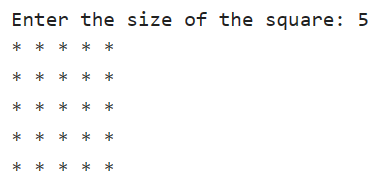Introduction
Printing patterns is a common exercise in programming that helps strengthen one's logical thinking and problem-solving skills. In this chapter, we will explore how to create a square star pattern in C++, breaking down the process from understanding the problem to implementing the solution.
Understanding the Problem
The square star pattern involves printing a square made up of asterisks (*). The size of the square is determined by user input or a predefined value. The goal is to generate a visually appealing pattern using nested loops and control structures.
Pattern Logic
Before we dive into the code, let's understand the basic logic behind square pattern printing. The idea is to use nested loop to control the number of rows and columns in the pattern. The outer loop is responsible for iterating over rows, while the inner loop controls the columns. By strategically using loops, we can manipulate the output to form a square pattern.
Algorithm
Before diving into the code, let's outline the algorithm to create a square star pattern:
- Accept the size of the square as input.
- Use nested loops to iterate throught each row and column of the square.
- Print an asterisk for each position within the square.
- Move to the next line after completing each row.
Code Implementation
Let's start with printing a solid square of asterisks.
#include <iostream>
int main() {
int size;
// Input the size of the square
std::cout << "Enter the size of the square: ";
std::cin >> size;
// Nested loops for square pattern printing
for (int i = 0; i < size; ++i) {
for (int j = 0; j < size; ++j) {
std::cout << "* ";
}
std::cout << "\n";
}
return 0;
}Output

Explanation
- The user is prompted to enter the size of the square.
- Two nested loops are used: the outer loop (
i) controls the rows, and the inner loop (j) controls the columns. - The inner loop prints an asterisk followed by a space for each column.
- After each row is printed, a newline character is added to move to the next line.
Complexity
Time Complexity: O(n^2), where n is the size of the square. This is because there are two nested loops, iterating n times. As a result, the total number of iterations is proportional to the square of the input size.
Space Complexity: O(1), as the program uses a constant amount of additional space, regardless of input size.
